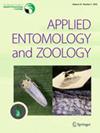Effect of pesticide use alteration on phytoseiid mite species composition and subsequent spider mite control using commercialized Neoseiulus californicus (Acari: Phytoseiidae) in Japanese pear orchards
Abstract
Our earlier study revealed that pesticide use considering the preservation of phytoseiid mites is crucially important for the effective utilization of commercialized Neoseiulus californicus (McGregor) (Acari: Phytoseiidae) release materials for spider mite control in Japanese pear orchards. Pesticide use alteration corresponding to commercialized N. californicus release material installation might change phytoseiid mite species composition and affect the efficacy of commercialized N. californicus in spider mite control. This study evaluated the effect of pesticide use alteration on phytoseiid mite species composition and subsequent spider mite control using commercialized N. californicus at Japanese pear orchards. We examined the population dynamics of spider mites and phytoseiid mites in Japanese pear orchards during 2019–2023. In 2022 and 2023, commercialized N. californicus release materials were installed at a Japanese pear orchard under conditions limiting the use of pesticides with adverse effects on phytoseiid mites. The results demonstrated that the most dominant species was shifted from N. californicus to Amblyseius eharai Amitai et Swirski (Acari: Phytoseiidae) with no significant suppression effects of commercialized N. californicus in spider mite control. The results also demonstrated a decline in the distribution of commercialized N. californicus to pear leaves. Amblyseius eharai and indigenous N. californicus dominantly existed in that order before commercialized N. californicus distribution to pear leaves. These results suggest that intraguild predation by A. eharai and competition with indigenous N. californicus might be involved in the less efficient distribution of commercialized individuals as major and minor factors, respectively.

 求助内容:
求助内容: 应助结果提醒方式:
应助结果提醒方式:


